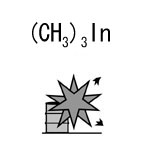| Case Name |
Explosion caused due to air contamination during subdivision work of trimethylindium |
| Pictograph |

|
| Date |
December 11, 1998 |
| Place |
Ube, Yamaguchi. Japan |
| Location |
Chemical factory |
| Overview |
An explosion accident occurred in the operation that subdivides trimethylindium, which ignites spontaneously on contact with air. A leak test was carried out after changing the shift. Then, information on the valve status was not properly communicated, and there was an air leak from the check valve. Trimethylindium ignited spontaneously with the air that flowed in. The operator at the time of the accident was the designer of the facilities. The situation at shift changing was not fully checked and there was a mistake in judgment. |
| Incident |
Trimethylindium, an organic metallic compound, exploded during subdivision in a 200 cc container at a chemical factory. At this factory, solid trimethylindium was carried in from outside, and was subdivided and shipped. The operation procedure was divided into halves.
In the first half of the procedure, a solid is sublimated by reduced pressure and heating. Generated vapor is transferred to an intermediate container with a vacuum pump, cooled, and solidified.
In the second half of the procedure, subdivision work is executed. An intermediate container is returned to normal pressure, and the solid is liquefied by heating, the liquid is dropped into a measuring drum beneath the intermediate tank by gravity. Subdivision work is carried out with sublimation as in the first half.
Purging by argon gas is performed by a valve operation between the steps mentioned above. |
| Processing |
Manufacture |
| Individual Process |
Filling and subdivision |
| Process Flow |
Fig2.Chemical formula
|
| Substance |
Trimethylindium, Fig2 |
| Type of Accident |
Explosion |
| Sequence |
In February, 1998. Subdivision equipment was designed and manufactured.
On December 1st. As there was a claim of contamination of air, filling equipment was converted to a continuous type.
On December 6th-7th and 8th-9th. Test subdivision was carried out.
On December 10th. Transfer to an intermediate container from a purchased container was completed as well as argon substitution
08:00 on December 11th. A leak was found in a leak test before starting the second half of the process. Argon was poured. It returned to normal pressure, and trimethylindium was heated for liquefaction. A leak test was performed at every time when subdivision containers were replaced.
10:00. An operator told the next shift operator that argon substitution had been finished, and a leak had been found by the leak test. The successor operated a valve in order to carry out a leak test again.
After about ten seconds, as the liquid in the bubbler had gone up to the check valve side, the valve, which had just been opened, was closed hurriedly. An explosion occurred at the next moment. Two operators were injured by flames and explosive pressure.
All of the trimethylindium burned. |
| Cause |
Trimethylindium spontaneously ignites on contact with air. When the valve was opened for a leak test, as air flowed into the intermediate container, it ignited. The procedure was divided into halves so that work of the first half and the second half could be done simultaneously. However, as a vacuum pump required for sublimation was used in both operations, there was an operating mistake with the valve.
The open and closed status of the valve was not correctly conveyed at the shift change. The check valve could not intercept air contamination completely. |
| Countermeasures |
As the work requires long time for sublimation, the work status must be reported correctly.
A display card indicating that a valve is open or closed should be installed.
A check valve should be doubled or an air opening portion should be substituted with an inert gas. |
| Knowledge Comment |
Communicating an open or closed status of many valves is difficult in fact. Probably, it would be good to use a drawing to describe how far the work procedure has progressed.
Although a check valve has a function that prevents a reverse flow, a reverse current cannot always be prevented completely.
At a plant where air contamination is inhibited, there should not be any part that is opened to the air. |
| Background |
Incorrect judgment (human error) by those who knew the facilities well, and an inadequate design (facilities management) were the basic factors. The operator who opened the valve was the designer of the facilities. Therefore, he judged the open and closed status of other valves was as scheduled as being designed, according to the work procedure, based on the information that argon substitution had been completed and the open/closed status of one or two valves.
In spite of air contamination being prohibited, there was a part open to the atmosphere. Two vacuum pumps should be prepared and used, one each for the first half and second half of the process. |
| Reason for Adding to DB |
Example of explosion caused due to incorrect judgment without confirming the situation |
| Scenario |
| Primary Scenario
|
Misjudgment, Misperception, Mis-Convincement, Carelessness, Insufficient Precaution, Carelessness of Operator, Organizational Problems, Inflexible Management Structure, Insufficient Education/Training, Malicious Act, Rule Violation, Safety Rule Violation, Planning and Design, Poor Planning, Poor Design, Bad Event, Chemical Phenomenon, Spontaneous Ignition, Secondary Damage, External Damage, Explosion, Bodily Harm, Injury, 2 person injured
|
|
| Sources |
Explosion in organic compounds manufacturing equipment. Industry and safety, Vol.14, No.47, p.5 (1998).
High Pressure Gas Safety Inst. of Japan, The high-pressure gas protection overview. 1999 edition, p.150 (2000).
The Res. Inst. of Industrial Safety material. (closed).
|
| Number of Injuries |
2 |
| Field |
Chemicals and Plants
|
| Author |
ITAGAKI, Haruhiko (Japan National Institute of Occupational Safety and Health)
TAMURA, Masamitsu (Center for Risk Management and Safety Sciences, Yokohama National University)
|
|